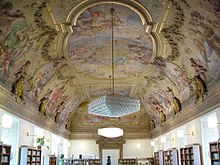|
Hradisko Monastery
   Hradisko Monastery or Monastery Hradisko (Czech language: Klášter Hradisko or Klášterní Hradisko, or simply Hradiště; colloquially also: Moravský Escorial, English: Castle Monastery or Hillfort Monastery) is a former monastery and a former village north-east of the city of Olomouc, nowadays a suburb of Olomouc. Originally a Benedictine monastery, from the mid-12th century a Premonstratensian monastery, located in the historical principality of Moravia and Margraviate of Moravia, now part of present-day Czech Republic. The large complex occupies an area of more than one hectare, since 1995 declared a cultural heritage site and is occupied by the Olomouc military hospital. EtymologyIn Moravia, Hradisko more often refers to a castle settlement—from Czech Hradiště (Hillfort, Gord): a fortified settlement from the Neolithic to Early Middle Ages, the forerunner of medieval castles and towns. HistoryNorth of Olomouc Castle, on the opposite left bank of the Morava River, lies a small rocky hill named Hradisko. A Přemyslid castle (settlement) was originally built on the site in 1030, which had been the seat of prince Otto I of Olomouc, the youngest son of Bretislav I Duke of Bohemia. Earlier colonization has also been evidenced by the archaeological finds around Hradisko monastery of abandoned settlements. In 1077, Otto and his wife Euphemia of Hungary invited the Benedictine monks from Břevnov Monastery to establish a monastery "in honour of the Saviour and Saint John the Apostle", and furnished the founding of Hradisko monastery with rich endowments. The abbey church was consecrated to Saint John in 1078 by the Olomouc Bishop Johannes I and in 1087 the site was therefore designated as "Saint John's Monastery of Olomouc suburb". Under the reign of the Přemyslid princes in Olomouc during 11th and 12th centuries, the monastery became the centre of spiritual life and a burial site for the Olomouc Přemyslids. Around 1140, the oldest Moravian chronicler, the so-called "Hradisko analyst" (hradišťský analista), a Benedictine monk, was in residence at the monastery. In 1151, the monastery reached a significant milestone when the Benedictine monks were expelled from Olomouc and the monastery was assigned to the Order of the Premonstratensians. The Benedictine monks were forced to leave Hradisko and found reception at the Opatovice nad Labem monastery (cs:Opatovický klášter) in east Bohemia. This change may have been linked more broadly with the former trend when the Premonstratensians became a mainstay of religious reform and the papacy, and therefore their arrival in the Czech lands was accompanied by hostility towards the Benedictines. In 1784, Emperor Joseph II abolished the monastery, ending more than six hundred years of the Premonstratensian monastery. At the time, more than 70 monks lived in the monastery, who mostly devoted themselves to spiritual administration. In the 18th century the monastery was a centre of Jansenism. After the secularization of church property in 1783, the monastery served as the Moravian General Seminary for the priesthood education until 1790. After the death of Emperor Joseph II, the seminary was cancelled and the former monastery was handed over to the army. The army established a warehouse at first and during the Napoleonic wars in 1800 a French prisoner of war camp. From 1802 it was used as a military hospital. Today, the freely accessible facility continues as home to the Olomouc military hospital. ArchitectureThe monastery grounds changed its appearance as the result of various historical events. During the centuries, Hradisko monastery was plundered, devastated and destroyed several times: 1241 by the Mongol invasion of Europe, 1429 by the Hussite Wars, 1432 by the Taborites, 1642 by the Swedish in the Thirty Years' War. The present-day buildings were built in the spirit of Italian Mannerism and High Baroque between 1661-1737 according to the plans of the Italian-Swiss architect Giovanni Pietro Tencalla known for his work in Moravia in the service of the Bishop of Olomouc, and the Italian architect Domenico Martinelli. The monastery building is one of the most valuable preserved works of Central European Baroque architecture and belong to the architectural splendours of its time. The almost square floor plan, 100 × 115 metres, consisting of the four-winged building with a rectangular platform, with corner towers and a moat, was built on the foundations of the old monastery, and is divided by an inner lateral wing into two parts - the Convent and the Prelature. Attractions
The former refectory ceiling artwork and sculpture of saint John of Nepomuk among other sculptures and reliefs in the ceremonial hall were created by Josef Winterhalder the Elder:
List of abbotsList of abbots of Hradisko Monastery till 1350:
Wikimedia Commons has media related to Hradisko Monastery. External links |
||||||||||||||||||||||||||||||||||||||||||
Portal di Ensiklopedia Dunia




